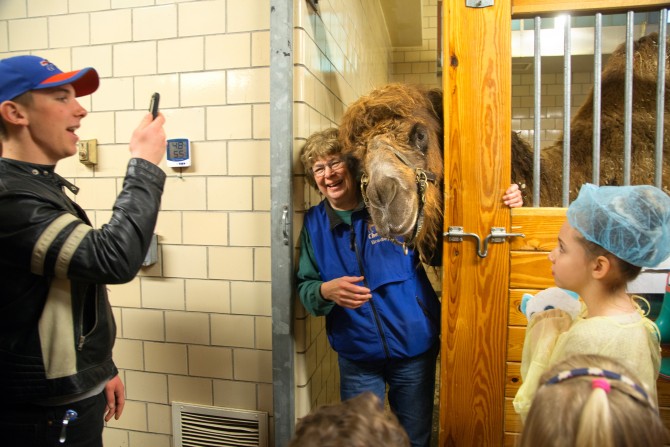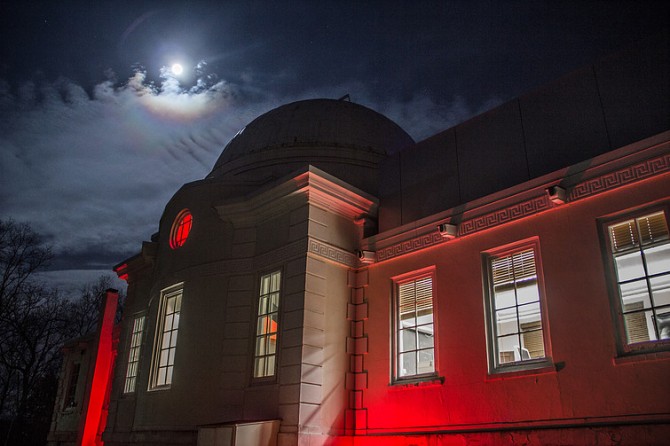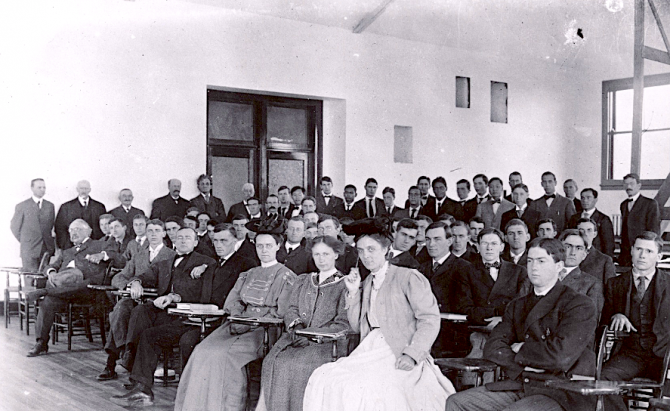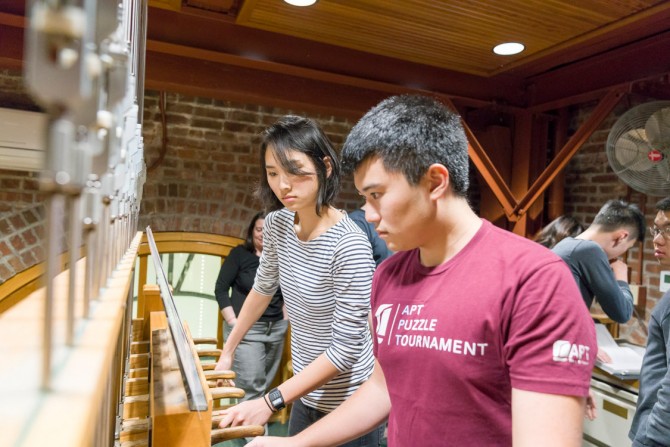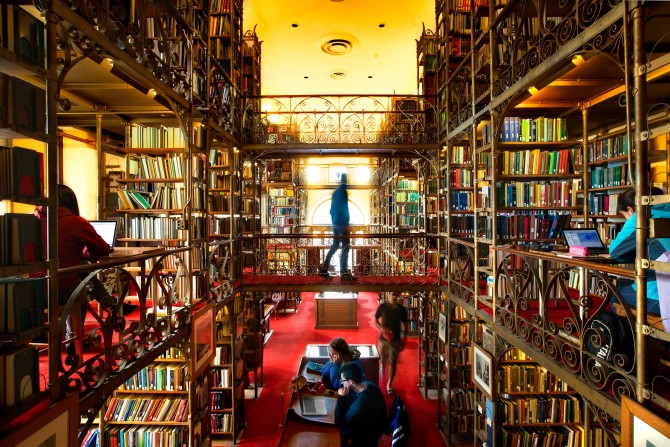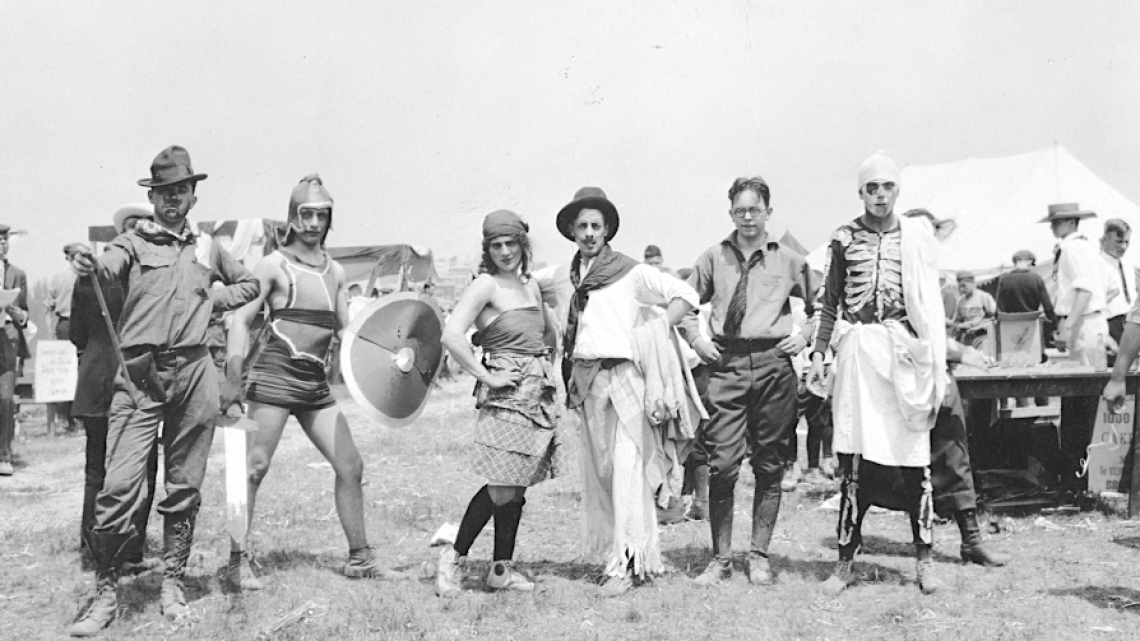
Students dressed in costume a century ago to celebrate Spring Day in 1922, a joyous occasion first held in 1901. Spring Day was a predecessor to the modern Slope Day.
New to campus? Discover Cornell’s rich history
By Blaine Friedlander
New Cornell University students, faculty and staff are entering a campus forged by history.
Before Cornell was founded, religious denominations built colleges and adhered to strict, dogmatic curricula. On Oct. 7, 1868, Cornell opened its doors and offered a secular education: The new university introduced an innovative, elective-course system, fully embraced diversity and had no ties to a church.
Eventually, nearly all universities in the United States adopted Cornell's approach to curriculum. This led historian Frederick Rudolph to call Cornell "the first American university."
Go anywhere on this campus, or in Ithaca, and you will encounter living history.
McGraw Tower
If you hear the Beatles' "Here Comes the Sun" resonating from the chimes at McGraw Tower, it's all right. Last week, the chimesmasters also played Chinese pop song "Xin Tai Ruan," Lin-Manuel Miranda's "Dear Theodosia" from the musical "Hamilton," and Nobuo Uematsu's composition "Rufus' Welcoming Ceremony" from the video game Final Fantasy VII. You can climb the 161 steps of the tower and enjoy daily concerts with a bird's eye view of campus.
Industrialist John McGraw funded the university handsomely for its early buildings. When he died, he bequeathed his wealth to his daughter, Jennie McGraw, who then became the wealthiest woman in the United States. She gave Cornell the original chimes and the tower that bears her and her father's name. The chimes were played when Cornell opened its doors on Oct. 7, 1868.
Dairy Bar
The sweetest place on campus, the Cornell Dairy Bar in Stocking Hall, last year sold 8,000 three-gallon tubs of ice cream - about 16.4 scoops per student. Further, the plant sold 10,000 comforting pints of flavors including mint chip, cookie dough, cookies and cream, and Triple Play Chocolate.
Today's food scientists stand on the shoulders of faculty such as turn-of-the-last century dairy professor Walter W. Fisk, Class of 1906, who in 1917 was asked by the U.S. Department of Agriculture to find more uses for dairy products and to see if skimmed milk was fit for human consumption.
Observing the heavens
On Fridays from 8 p.m. to midnight during the academic year, the Fuertes Observatory adjacent to the North Campus residence halls opens up the heavens to the public. Members of the Cornell Astronomical Society provide rooftop views for your planetary enjoyment, or check out the 12-inch Irving Porter Church refracting telescope built in 1917. Campus observatories once taught engineering students how to operate cutting-edge surveying tools.
The late Cornell astronomy professor Carl Sagan gained fame for his pioneering television program "Cosmos," on PBS in the late 1970s. He frequently appeared on talk shows to explain the universe. Today, thanks to the Ithaca Sciencenter's Sagan Planet Walk in downtown Ithaca, you can appreciate the scale of the solar system - from the sun (on The Commons) to Pluto (on Franklin Street, three-quarters of a mile away).
A festive past
While Ithaca is gorges, it's also festivals. Slope Day on campus started well over a century ago as Spring Day in 1901, founded by Willard Straight, Class of 1901, as a fundraiser for university athletics. Straight also helped to organize the first Dragon Day that same year.
This fall, the first-ever Cayuga Sound Festival - organized by Ithaca's own hometown band X Ambassadors - falls on Saturday, Sept. 23. It features two stages at Stewart Park and a mix of world-class acts. Enjoy Porchfest 2017 Sunday, Sept. 24, as musicians and bands - mostly acoustic - perform free from the porches and stoops of Ithaca's Fall Creek and Northside neighborhoods.
Sip hot apple cider and savor kettle corn at downtown Ithaca's 35th Annual Apple Harvest Festival Sept. 30-Oct. 1.
At the end of October, gather your Gryffindor gang for Wizarding Weekend Oct. 27-29 at Press Bay Alley, "Diagon Alley" from the Tompkins County Public Library and on The Commons.
Considering that Cornell offered the first veterinary degrees in the United States, plan for the College of Veterinary Medicine's popular annual open house April 14.
Gardens
The shed adjoining the Pounder Vegetable Garden and the Climate Change Garden - part of 25 acres of the Cornell Botanic Gardens - is where Nobel Prize-winning plant geneticist Barbara McClintock worked as a Cornell graduate nearly 100 years ago. Also enjoy the 150-acre F.R. Newman Arboretum.
At the Botanic Gardens' Brian C. Nevin Welcome Center, an exhibit on natural dyes - in partnership with Denise Green, assistant professor of fiber science and apparel design - will be installed in early December. Green and her students created a dye plant garden near Martha Van Rensselaer Hall a few years ago.
This summer, Cornell's Titan arum - known as the corpse plant - has been hurling its pungent stench outdoors at Minns Garden on Tower Road. There are other more-aromatic plants there, too.
The telling of telling time
Dashing to an engineering class? Ensure you're on time by setting your watch to the Joseph N. Pew sundial, designed almost 40 years ago by Dale R. Corson, Cornell's eighth president, and Richard M. Phelan, mechanical and aerospace engineering professor. It is among the most accurate sundials in the world.
In 2011, Bill Nye '77, the Science Guy, helped Cornell harvest the sun with the Solar Noon Clock atop Rhodes Hall. When the sun reaches its highest point in the sky daily, a spot under the numeral 12 brightens for a few minutes. Just a note: It's around 1 p.m. during Daylight Saving Time.
Libraries
Daniel Willard Fiske - who married Jennie McGraw - served as Cornell's first librarian from 1868 to 1883. The University Library, now Uris Library, opened Oct. 7, 1891, and the university's first president, Andrew Dickson White, called it "the noblest structure in the land." It was designed by William Henry Miller, Class of 1872, who also designed Risley Hall, the old Ithaca High School (now the Dewitt Mall building downtown) and the Cascadilla School on Oak Avenue in Collegetown.
At the Division of Rare and Manuscript Collections in Kroch Library, an exhibit on witchcraft opens Oct. 31, with centuries-old artifacts that were once part of A.D. White's personal collection. The library also will celebrate the 100th anniversary of women's suffrage in New York state with exhibits at Mann and Kroch libraries. Historians Carol Kammen and Elaine Engst will give a talk Nov. 9 at Mann.
We are where we eat
A.D. White dismissed the idea of dining halls. It wasn't the university's obligation, he said. Students ate with Ithaca families, at boarding houses and at Greek houses. But about 100 years ago, alumni began to insist on building dining halls.
Today, Cornell Dining ranks among the nation's best, thanks to executive chefs like Kevin Moore, who serves fresh vegetables, fruits and other delicious, healthy fare at the Robert Purcell Marketplace Eatery. For example, "Blended Sliders" includes combinations like beef and mushroom, lentil and rice, and turkey and apricot.
Taste history at North Star Dining Room, where the salad bar serves the original historic recipe of Thousand Island dressing that Cornell trustee George Boldt (original proprietor of the Waldorf Astoria Hotel and namesake of Boldt Hall) adored. Murray Lalonde - great-great grandson of that dressing's creator, Sophia Lalonde - manages the North Star and brought the original recipe to Cornell.
Savor days gone by at the Atrium Cafe at Sage Hall - formerly the university's first residence hall for women, built in 1875. Dining in The Ivy Room at Willard Straight Hall? Here's a little movie Cornelliana: Willard's daughter, Beatrice Straight, won an Academy Award in 1978 for her role in "Network."
The art of education
The Herbert F. Johnson Museum of Art, named for Herbert Fisk Johnson Jr., Class of 1922, houses more than 35,000 works. The building was designed by famed architect I.M. Pei, who also designed the East Building of the National Gallery of Art in Washington and the Louvre Pyramid in Paris. On Sept. 2, the museum hosts a new exhibit: "From the Darkness of the Sea: The Cornell Collection of Blaschka Glass Invertebrate Models," the historic collection of glass marine animals by Leopold Blaschka and his son Rudolf, acquired by Cornell in 1885 for use in teaching in the sciences.
Other historical campus collections worth finding include the cerebral Wilder Brain Collection, on the second floor in Uris Hall, as part of the psychology department. Students may conduct independent research using the Anthropology Collections in McGraw Hall. For people geared toward engineering, it's poetry in geometric motion at the Reuleaux Collection of Kinematic Mechanisms in Duffield Hall's Baum Atrium.
Media Contact
Get Cornell news delivered right to your inbox.
Subscribe